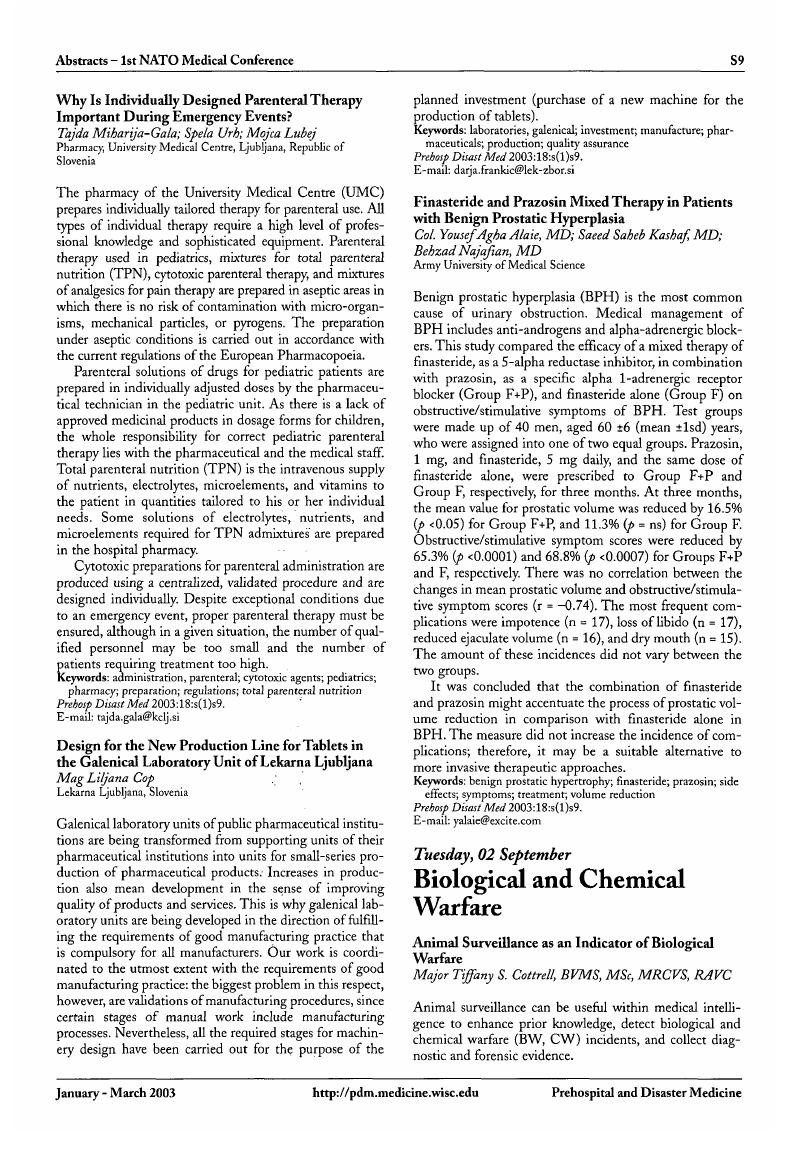No CrossRef data available.
Article contents
Animal Surveillance as an Indicator of Biological Warfare
Published online by Cambridge University Press: 17 February 2017
Abstract
An abstract is not available for this content so a preview has been provided. As you have access to this content, a full PDF is available via the ‘Save PDF’ action button.

Keywords
- Type
- 1st NATO Medical Conference Civil-Military Co-operation
- Information
- Copyright
- Copyright © World Association for Disaster and Emergency Medicine 2003
References
Further Reading
1.
Eidson, M, Komar, N, Sorhage, F, Nelson, R et al; 2001. Emerging Infectious Diseases
7(4) p 615-620: Crow Deaths as a Sentinel Surveillance System for West Nile Virus in the Northeastern United States, 1999.CrossRefGoogle Scholar
2.
Mostashari, F, Kulldorff, M, Hartman, JJ, Miller, JR, Kulasekera, V; 2003. Emerging Infectious Diseases
9(6) p641-646: Dead Bird Clusters as an Early Warning System for West Nile Virus Activity.CrossRefGoogle Scholar
3.
Guptill, SC, Julian, KG, Campbell, GL, Price, SD, Marfin AA; 2003. Emerging Infectious Diseases
9(4) p483-484: Early- Season Avian Deaths from West Nile Virus as Warnings of Human Infection.CrossRefGoogle Scholar
4.
Douglass, RJ, Kuenzi, AJ, Williams, CY, Douglass, SJ, Mills, JN; 2003. Emerging Infectious Diseases 9(3) p390-392: Removing Deer Mice from Buildings and the Risk for Human Exposure to Sin Nombre Virus.Google Scholar
5.
Ali, R, Mounts, AW, Parashar, UD, Sahani, M et al; 2001. Emerging Infectious Diseases
7(4) p759-761: Nipah Virus Infection Among Military Personnel Involved in Pig Culling During an Outbreak of Encephalitis in Malaysia 1998-1999.CrossRefGoogle Scholar
6.
Boisier, P, Rahalison, L, Rasolomaharo, M, Ratsitorahina, M et al; 2002. Emerging Infectious Diseases
8(3) p311-316: Epidemiologic Features of Four Successive Annual Outbreaks of Bubonic Plague in Mahajanga Madagascar.CrossRefGoogle Scholar
7.
Sorvillo, F, Ash, LR, Berlin, OGW, Yatabe, J, DeGiorgio, C, Morse, SA; 2002. Emerging Infectious Diseases
8(4) p355-359: Baylisascaris procyonis: An emerging Helminth Zoonosis.CrossRefGoogle Scholar
7.
Sorvillo, F, Ash, LR, Berlin, OGW, Yatabe, J, DeGiorgio, C, Morse, SA; 2002. Emerging Infectious Diseases
8(4) p355-359: Baylisascaris procyonis: An emerging Helminth Zoonosis.CrossRefGoogle Scholar
8.
Reintjes, R, Dedushaf, I, Gjini, A, Jorgensen, TR et al; 2002. Emerging Infectious Diseases
8(1) p69-73: Tularaemia Outbreak Investigation in Kosovo: Case Control and Environmental Studies.CrossRefGoogle Scholar
9.
de Souza Trindade, G, Guimaraes da Fonseca, F, Trindade Marques, J, Lacerda Nogueira, M et al; 2003. Emerging Infectious Diseases
9(2) p155-160: Aracatuba Virus: A Vaccinialike Virus Associated with Infection in Humans and Cattle.CrossRefGoogle Scholar
10.
Ashford, DA, Gomez, TM, Noah, DL, Scott, DP, Franz, DR; 2000. Journal of the American Veterinary Medical Association
217(5) p664-667. Biological Terrorism and Veterinary Medicine in the United States.CrossRefGoogle Scholar
11.
King, L, Khabbaz, R; 2003. Emerging Infectious Diseases
9(4) p510-511: Converging Issues in Veterinary and Public Health.CrossRefGoogle Scholar
12. World Health Organization; 2002. Future Trends in Veterinary Public Health: Report of a WHO Study Group (Technical Report Series, Number 907).Google Scholar


